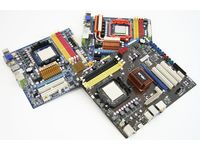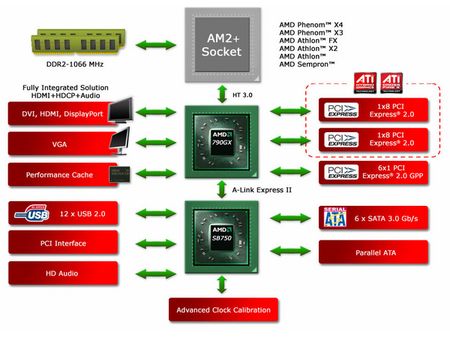AMD 790GX: RV610 For Enthusiasts?
Integrated Graphics Go High-End
AMD and Nvidia are in the process of playing musical chairs. Earlier this year, both vendors unveiled integrated chipsets loaded with features that far surpassed anything seen before in the onboard graphics market.
AMD’s own solution went right for the mainstream — in our opinion, the smartest place to aim if you also happen to be selling mid-range processors. Its 780G opened the door to modest 3D performance in older titles and a reasonable Vista experience. Best of all, it powered motherboards priced as low as $60. Add a sub-$200 quad-core processor to the mix and you’re talking about a surprisingly beefy hardware combination.
On the other hand, Nvidia’s offering reached right up into the enthusiast space, where gamers cared less that its 780a SLI platform included a “motherboard GPU” and more that a pair of GeForce 8800s in SLI could be turned off to save power while idling on the Windows desktop. We’re not sure how many folks were willing to spend more money now with the hope of saving a few bucks per month in energy, but a $200 board paired to a $200 processor just doesn’t have the same ring to it (especially when Intel’s Core 2 Duos and Quads are laying down better performance numbers).
Role Reversal
Nvidia wasted no time in launching a 780a SLI follow-up able to better compete for mainstream attention. Its GeForce 8300 chipset flies right in the face of AMD’s 780G, delivering compelling performance and more advanced storage functionality from a single-chip platform. Of course, GeForce 8300-based motherboards are also much more affordable than anything employing 780a SLI.
Despite its entry-level billing, the GeForce 8300 includes a lot of the same value-added functionality introduced with 780a SLI — the two headline features being GeForce Boost and HybridPower. Of course, GeForce Boost lets you drop a low-end GPU into an available PCI Express x16 slot and run a quasi-SLI configuration. As it pertains to Nvidia’s integrated enthusiast chipset, GeForce Boost makes no sense whatsoever. But as part of the GeForce 8300, it’ll probably see a little more action as budget-conscious buyers add GeForce 8400 GS and GeForce 8500 GT cards for a moderate pop in frame rates.
HybridPower, however, is more exciting. Briefly, the feature employs intelligent display routing to power down discrete cards during idle periods, instead using the integrated core’s output circuitry. A gamer running a couple of GeForce 9800 GX2s, for instance, could cut back on a lot of power consumption, heat, and fan noise by going that route. Granted, the GeForce 8300 chipset only supports a single x16 PCI Express 2.0 link, so HybridPower will only work with one card.
Get Tom's Hardware's best news and in-depth reviews, straight to your inbox.
AMD Goes For The Gold
With aspirations beyond “this chipset is great for casual gamers and small businesses,” AMD has revisited some of the criticisms leveled at the 780G and is now looking to take a bite out of a more discerning slice of the market with a brand new integrated chipset called 790GX.
Notice that the platform shares its model designation with AMD’s flagship 790FX chipset. Clearly, the company feels that this northbridge, coupled with a reworked southbridge, is capable of taking a relatively mainstream set of features to a place where enthusiasts play.
-
kitsilencer Great review, and it's good to see that AMD is at last able to target more enthusiast markets competitively.Reply -
cangelini kitsilencerGreat review, and it's good to see that AMD is at last able to target more enthusiast markets competitively.Reply
Thanks for the feedback Kit. -
waffle911 So... why does a page 15 and 16 of this article exist if there is no page 15 or 16 to the article?Reply
Take a closer look. What happened? -
YYD PCMark seems Intel biased, please read this:Reply
http://arstechnica.com/reviews/hardware/atom-nano-review.ars/6
Please change this benchmark suite or check if PcMark Vantage is unbiased. -
cangelini waffle911So... why does a page 15 and 16 of this article exist if there is no page 15 or 16 to the article?Take a closer look. What happened?Reply
That was strange. Should be fixed now.
-
cangelini YYDPCMark seems Intel biased, please read this:http://arstechnica.com/reviews/har view.ars/6Please change this benchmark suite or check if PcMark Vantage is unbiased.Reply
Fortunately, with no Intel platforms tested, this should be a non-issue for the current situation ;-) In the future, you'll be seeing SYSmark, though. -
Seems past page 8 or something the links are corrupt.. can't fully read this article and getting error 404 - page not found.Reply
-
cangelini lacrits.. and now the article seems to be removed even from the main page!?!?!Reply
Alright, mystery solved. It's back up, sans the blank page. Thanks for pointing that out lacrits!


